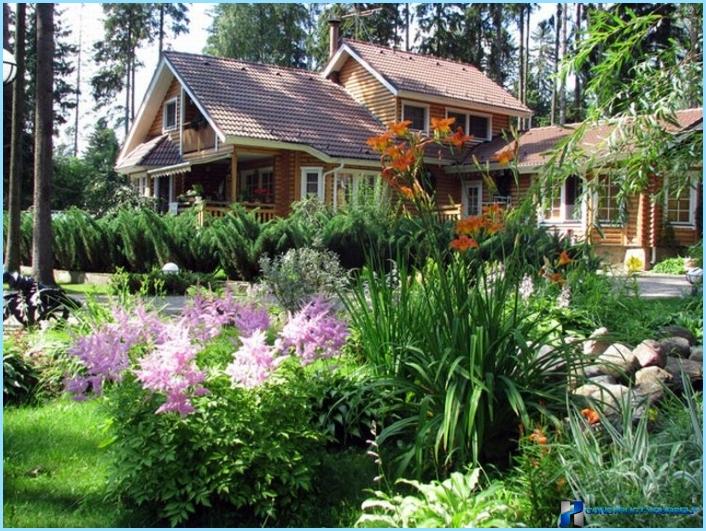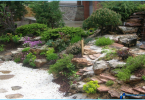The contents
In order to successfully choose plants for landscape gardening your garden, you must consider the climatic conditions of the region, peculiarities of the terrain, presence of buildings, the degree of moisture of the soil, problem areas, and also the style in which you would like to take your option of landscape design.
Besides, it is necessary when choosing plants take into account their natural habitat, in what conditions they feel great, not to make the wrong choice and make your landscaping not only look good, but viable.
Kinds astilbe height ↑
You can stay for undemanding plants that require less habitat. Such plants used for decoration of different styles of landscape design, include numerous varieties astilby.
Height astilbe are:
- dwarf – up to 30 cm;
- short – from 30 to 60 cm;
- medium – up to 90 cm;
- tall tall up to 150 cm.
In the wild astilbe distributed in China, Mongolia, Japan, North America.

In natural conditions it is known about 30 species of this plant. Thanks to the work of breeders derived many varieties and hybrids differ in color, size, and flowering periods. In landscape design used varieties of various shades of pink, purple colors and white and cream, different astilbe by the size and shape of the flowers. There are from 200 to 300 varieties and hybrids.
Different varieties astilbe flowering occurs at different times, starting in June and ending in late August. Using this, you can create a composition in a landscape design that will bring you joy blooms throughout the summer.
The types of inflorescences ↑
Different astilbe also in the form of buds, there are 4 types of inflorescences:
Pyramid – resemble the shape of a regular pyramid, decreasing from the base to the apex, lateral buds go almost at a right angle to the Central inflorescence, and then converge at the apex;

Rhombic (geometrically similar to the diamond) side of the inflorescence with the main form an acute angle. This form inflorescences in astilbe Japanese;

Paniculate form (found in astilba Arends) – multiple branches with a large number of branches depart from the base at an acute angle and tapering to the top;

Drooping shape (astilba Thunberg and Lemoine) – inflorescence with flexible drooping tassels beautiful dangling arcs.

Application astilbe in landscape design ↑
How to use the astilba in landscape design, is determined by the style in which you want to make a garden plot. She is the ornament of the garden during the whole period of development, from the appearance of the first leaves in the spring to complete drying plants in the fall. Astilba in landscape design is interesting not only in the flowering period (photo), decorative have and leaves.

A nice surprise in the landscape design of the beautiful purple color of emerging leaves, along with the growth they acquire traditional green color, but unusual shape, as if carved. Advantageous to use in the design of any of the songs, the flowering lasts at least a month, during this time, you will have time to enjoy the color and shapes of flowers. Flower color is a nice soft colours, a whole range of pink, lilac shades look spectacular with a white and cream instances.
Planting groups ↑
These flowers can be planted in the landscape addressing individual instances and groups in the design to match different colors and sizes.

The astilba can be planted in any flower garden, she will fit well in your chosen option of landscape design thanks to its versatility. Because of the possibility to use plants of different heights to astilba can be planted in the first rows of the flower garden, and making the average or the background design. Small species appropriate fit in the landscape decision at an Alpine slide. Tall will find use for decorating unsightly plots of landscape design, for example, are a great option green fence, closed from prying eyes outbuildings. In design you can arrange the flowers along the tracks, singly and in groups.

Planting on beds ↑
From dwarf varieties use landscape design a border for flower beds, lawns. If you put Bush in astilbe flower pot, it will serve as decoration design with open porch or garden gazebos.

Flowers-neighbors for astilbe ↑
Astilba in harmony in the landscape combined with other plants of the garden, easily fits into the design with conifers, e.g., cedars, junipers, looks great with the hosts and ferns. A good combination will be openwork leaves astilbe and large whole leaf of hellebore, bergenia, podophyllum, the colorful, cuff. For decoration of landscape design it was planted next to the day lilies, analysis, ferns, lilies, Phlox, geranium.

It is possible to create an interesting design, if you apply the landscape is a combination of astilbe with spring flowering perennials such as saxifrage, repucci, dead-nettle. In early spring, while astilba will grow up, its neighbors will create a decorative landscape design, and after their flowering will take over the accent in floral arrangements. Astilba planted the spring garden with snowdrops, crocuses, tulips, lilies, rhododendrons.

Astilba make good company colors, which exposed the lower part, due to its abundant decorative foliage it will help to hide the flaws of the neighbors. It grows well in shady areas, under trees, in shade houses, diluting its beautiful flowers, the greenery, shade-loving plants. Usually hard enough to pick up a flowering plant, which will be good to feel the lack of sunlight, astilba fine will help you to solve the problem of landscape design.
How to choose a location for astilbe ↑
If it is planted in full sun, flowering will be reduced to about two weeks, the flowers can fade in the sun. If you want to use this plant in the landscape design for full sun locations, it is better to choose fit for this class, for example, the Chinese dwarf astilba, varieties Stratosfear, Diamond, Freda KLAPP. Astilbe must be a sufficient amount of moisture in arid areas or during dry summer you need to take care of additional watering. Perhaps in very dry climates need to water it daily.

Astilba likes wet places of the garden, would look great on the banks of reservoirs, as single plants and planted along the shoreline. If you design to include a pond in your option of landscape design, for example, a stream or artificial lake, it is appropriate to use the astilba for landscaping in the coastal zone.

The well will feel the perennial and in the swampy areas in the lowlands and areas with overly moist soil. When adequate soil moisture in spring you can feed the astilba mineral fertilizers with the addition of a nitrogenous component, and after flowering, phosphorus and potassium. In dry soil from mineral supplements should be abandoned, replacing them for making compost and mulching with peat.
Care astilbe ↑
Astilba undemanding and will grow in any soil, if there are options, it is better to prefer light slightly acidic soil, with organic fertilizers. It will promote the best growth and abundant flowering plants. If it is not possible to mulch the land with peat or compost, suitable and other options, you can use dried shoots from astilbe.
As it relates to long-term, will not need every year to planting new specimens. Requires little or no shelter for the winter, no freezes, and fast growing, which allows you to use your own planting material for further propagation of this remarkable plant.

The undeniable advantages of astilbe include its availability in acquisition for all comers. It is most convenient to propagate it by dividing the bushes, this is the most popular way of easy work and high survival rate of plants. In addition, the cuttings of any species can be ordered by mail. Even after drying, the cuttings, if your parcel is delayed in the road, you can bring them back to life, soak them for a day in a solution of Alpin, growth stimulant, and then planted in the ground.
This plant even in winter can serve as a decoration of your landscape design. If you do not prune after flowering, it retains decorative look throughout the winter, this property is astilbe used in dry areas of Western Europe and North America.
Looks good astilba and in dried form, it preserves the saturation of colors and used to create compositions of dried flowers, both independently and with other plant.
Conclusion ↑
Thanks to its versatility, the plant will wonderfully fit into any chosen option of creating a landscape design, but because of its simplicity it has rightfully earned the title «plants for the lazy».







